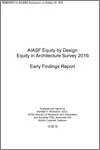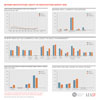Announcing 2016 Equity in Architecture Survey Early Findings
 Other News
Other News Subscribe to FREE newsletter
Subscribe to FREE newsletter
| Nov 05, 2016 |
The American Institute of Architects, San Francisco’s (AIASF) Equity by Design Committee is pleased to announce early findings of the 2016 Equity in Architecture Survey during the sold out Equity by Design Symposium: Metrics, Meaning, & Matrices held at the San Francisco Art Institute, Saturday, October 29, 2016. As the day’s events unfold, follow the Twitter hashtag #EQxDM3.
The survey results reflect the ways that careers in architecture differ by gender and race and the potential career dynamics and pinch points that affect talent retention; and offer insight into ways individual practitioners, employers, and the industry can make changes that promote satisfying careers in architecture for women and men alike, improve employee retention, and, ultimately, improve companies’ bottom lines.
“AIASF’s 2016 Equity in Architecture Survey early findings highlight the income disparities between men and women in architecture, and point to the work-life flexibility that the industry and its professionals need,” said Jennifer Jones, CAE IOM, Executive Director of AIASF. “The results of the survey have generated significant conversation around the satisfaction of architects and I look forward to the architectural community championing institutional change.”
“I am proud to have AIASF leading the conversation on equity in architecture,” states Aaron Hyland, AIA, Principal of CannonDesign and President of AIASF. “This year’s results add to an ongoing conversation for how we can improve the workplace for both women and men, ensuring retention and quality of life for those who shape our built environment.”
The 2016 Survey, conducted between February 29 and April 1, 2016, resulted in the analysis of 8,664 completed responses to over 80 questions. The survey questions were posed to Architecture School Graduates in the United States. The survey questioned professional experiences, backgrounds, and aspirations of professionals who either currently work in an architectural practice; have worked in an architectural practice in the past, but are currently employed in another profession (either in an aligned AEC field or not); or have worked in an architectural practice in the past, and who are either currently not employed, taking a career break, or leave of absence.
The 2016 Equity in Architecture Survey demonstrates that women and people of color continue to lag behind white men in concrete measures of career success such as annual salary and likelihood of leading a firm. Male respondents’ perspectives on their careers were also more positive on average than those of their female counterparts. Female respondents were less likely to feel energized by their work, less likely to feel that their opinions were valued, and, ultimately, less likely to say that they planned to stay at their current job.
While there were stark differences between men’s and women’s salaries, career advancement, and perspectives, gender wasn’t the driving predictor of success within the profession. Factors like transparency in the promotion process, having access to a senior leader in one’s firm, receiving ongoing feedback about one’s work, sharing values with one’s firm, and having meaningful relationships at work were much more strongly correlated with all of these measures of success. Male respondents were more likely to report having access to each of these ingredients for a satisfying career in architecture.
Early findings show that pay equity is the most consistent stratification between men and women, with men’s salaries consistently higher than women with similar experience levels, regardless of caregiver roles, project roles, firm size, or negotiating ability.
Results from the survey demonstrated that men averaged $94,212/year and women averaged $71,319/year; a difference of $22,893/year. When controlled for years of experience, men averaged higher salary ranges 100% of the time. Data showed a gender-based wage gap for every project role, with the largest gap between men and female design principals. While it was found that women were likely not to negotiate their salary increases and bonuses - accepting compensation that did not meet their expectations - survey results found that women who negotiated their salaries were less likely to cite an unsuccessful attempt at negotiating raises when compared to male counterparts.
While men and women both agreed they have enough time and energy to pursue interests outside of work, the following options promoted work-life flexibility and were likely to be used by both men and women: flexible start and end times in office, technology to support working remotely, and telecommuting/work from home. Women were more likely to use time off in exchange for overtime hours worked and a part-time schedule. It was found that this work-life flexibility is paramount to the role of women as caregivers, who take an unparalleled amount of time off for the birth of a child and being responsible for most of the childcare.
Men and women are most likely to pursue architecture licensure for the ability to call oneself an architect (58%M, 66%F), the ability to practice independently (63%M, 59%F), and for heightened professional standing (50%M, 54%F). However, those that did not pursue licensure, did so because there wasn’t a need in order to meet their career goals. Men were found to be 15% more likely to be licensed than women, with the average time from graduation to licensure for both men and women falling between six and seven years.
Brochures



 AIA (American Institute of Architects)
AIA (American Institute of Architects)